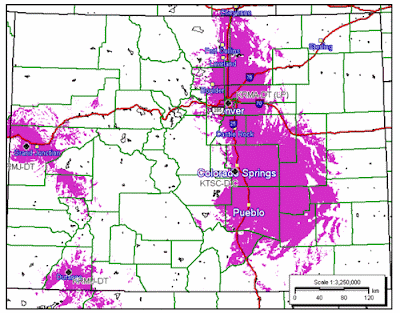Thirty
years ago I was completing my Masters of Mass Communication degree at Arizona
State University in 1986 while I was GM of KCSU, Fort Collins, Colorado. The
topic of my thesis is “the channel six problem,” an issue created by the FCC
and big corporate broadcasting. The ruling fluke pitted noncommercial radio
broadcasters against television stations.
 |
| KRMA TV COVERAGE IN 2015 |
I
was fortunate to have the perfect location to do the field test for my thesis:
Colorado’s Front Range. KCSU was/is
located in Fort Collins about fifty miles north of Denver and the transmission
point for KRMA-TV channel six. Around a
dozen noncom stations were in KRMA’s coverage area.
In
my thesis, I examined origins of “the channel six problem.” Yesterday’s post is
PART ONE in the series. Today in PART TWO we tell of the robust FM growth in
the years just prior to World War 2. In
1941, there were 46 FM stations operating, including 5 noncom stations. FM was heard between 42 and 50 mHz on the
dial.
When
the war ended RCA and other big manufacturers and broadcasters wanted the FCC
to move quickly to expand television broadcasting. The corporate interests
coveted the spectrum between 42 and 50 mHz.
That electronic real estate was where they wanted to place TV Channel
One. The FCC gave the TV folks
everything thing wanted, but it meant the immediate end FM radio as it then
existed.
TV
won the day by presenting the FCC with closed testimony of “secret classified data”
that falsely showed that the FM dial, between 42 and 50 mHz, was vulnerable to
interference of sun-spot. Because it was “secret testimony” it couldn’t be
refuted. One FCC Commissioner said moving the entire FM dial was “for FM’s own
good.”
On
June 27, 1945, the FCC announced that FM stations had to move “up the dial” to
86 mHz – 108 mHz.
PART TWO OF THE STORY
THE IMPORTANT EXAMPLE AT WFIU-FM
Bloomington,
Indiana is about 60 miles southwest of a channel six TV station in
Indianapolis. Many people who watched
channel six, experienced interference from WFIU-FM. The FCC did not take any action.
TOMORROW: THE CASE
STUDY OF INTERFERENCE ON COLORADO’S FRONT RANGE
















No comments:
Post a Comment